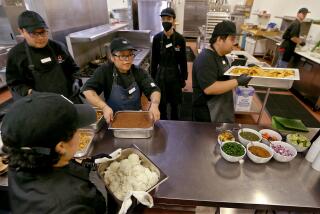U.S. Army Looking for Good Chefs : New Generation of Cooks Is Making Great-Tasting Dishes
- Share via
FT. LEE, Va. — A hairy, tattooed arm slinging slop onto a cold plate held by a wary soldier is the glum image many people have of dining in the Army.
But Army food, while at times still considered edible at best, is changing in a big way. It’s a long way from the hash and beans of the old days to the petits fours and muffin sculptures of today, but it is the route taken by Army cooks baking up a new image.
“We’ve still got the Beetle Bailey image to some extent,” said Maj. Neil H. Hatton, a British Army officer brought to the United States as part of an exchange program to direct the Culinary Skills Division at Ft. Lee where the Army trains its cooks.
Push Toward Nutrition
Army cooks today are taught how to prepare meals like chefs in any restaurant kitchen, with a push toward better nutrition. Never, however, at the expense of such just-like-home treats as pastries that even tough Army cooks take great pride in.
“The thing that amazes people is the Army is taking the lead nationally and internationally in food preparation,” Hatton said.
Indeed, the U.S. Army Culinary Arts Team, a collection of the best dozen cooks in the Army, beat out the finest restaurant chefs in the nation last year to win the grand prize at the nation’s premier cooking show, the National Culinary Arts Salon and Exhibition in Chicago. One member of the team received a gold medal for an exquisite wedding cake and other pastries.
In addition, the Army team was the only group of military cooks invited to the international culinary olympics last fall.
Still, the efforts of the cream of the Army’s 19,000 cooks, do not necessarily represent typical Army food.
“It’s all part of our effort to raise the image from the sloppy stuff,” Hatton said. “We don’t do this every day, but it shows it can be done.”
For Army cooks, it all begins at Ft. Lee, 25 miles south of Richmond, Va.
“Students come here never having cooked before,” Hatton said. “The first two weeks they are instructed in things like: What is a carrot? What does it look like? How do you boil it? Real basic stuff.”
Food always has been a hot--although sometimes not very tasty--topic in the military. But solutions were tough to come by.
The real change in attack came when the draft was dropped and the volunteer Army was ushered in, Hatton said.
‘Make Him a Cook’
“When the draft was held, you probably had a regimental reject as a cook,” Hatton said. “He couldn’t hold a rifle right, so they said, ‘Make him a cook.’
“Now, I think many people join the Army because they are looking for a trade and they want to learn how to cook. Besides, I don’t think many people are going to be able to get a job firing a tank after they get out of the Army.”
To boost the new attitude toward cooking, in 1973 the U.S. Army began an exchange program with the British army in which a major and two instructors from each nation swap places to get a fresh look at military cooking.
The results have been remarkable, with last year’s national culinary show being the highlight. But this is the Army, not a cooking school, and there are difficulties in working within the military regimen.
Hatton’s 86 instructors have eight weeks to train raw recruits in the art of cooking. Then that bunch is off to an assignment and a new group comes in. About 2,000 students go through the basic cooking training each year.
“Eight weeks is far too short,” Hatton said. “Teaching someone to cook can take years. All we can do in eight weeks is basic skills and hope they go on to get more skills.”
The training, brief as it might be, is intense.
Said Lawrence White, 20, of Kalamazoo, Mich., a student whose previous encounters with food included sweeping the floors at a McDonald’s: “When I first got here, I was lost. But you get into the swing of things real easy.”
After learning about carrots, students are taught how to read recipes, as well as lessons in paper work and maintaining food supplies to feed an Army.
Things get creative during field training, when students prepare meals under battlelike conditions. One recent dinner prepared during field exercises included shrimp Creole, rice, broccoli, cornbread and pineapple upside-down cake.
More to Read
Eat your way across L.A.
Get our weekly Tasting Notes newsletter for reviews, news and more.
You may occasionally receive promotional content from the Los Angeles Times.







